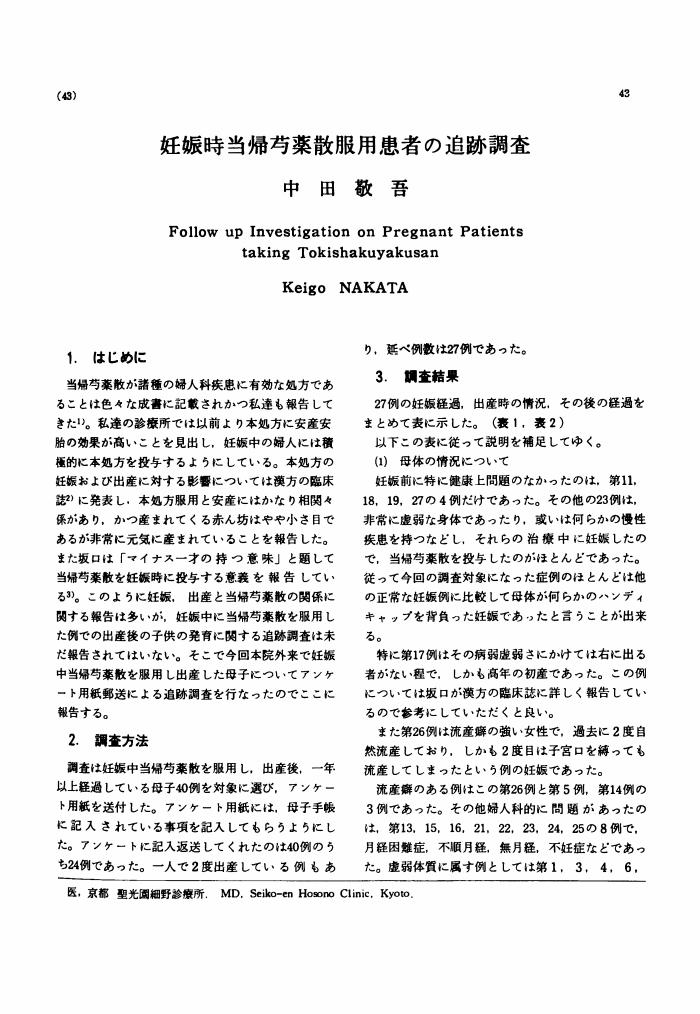2 0 0 0 表面プラズモン共鳴法による水晶体蛋白質凝集に関する研究
- 著者
- 亀井 鑠 松浦 伸之
- 雑誌
- あたらしい眼科 = Journal of the eye (ISSN:09101810)
- 巻号頁・発行日
- vol.18, no.2, pp.262-264, 2001-02-28
- 参考文献数
- 8
2 0 0 0 OA 北米運河史研究
第1章 アメリカ産業革命と運河時代………………………………… 1第2章 19世紀アメリカの主要運河………………………………… 31第3章 イリー運河の建設……………………………………………… 57第4章 運河建設と民衆………………………………………………… 79第5章 イリー運河経営の成功………………………………………… 98第6章 運河沿い地域の発展…………………………………………… 120第7章 鉄道時代の到来と運河輸送…………………………………… 143第8章 カナダ内陸水路の改良………………………………………… 164第9章 ラシーヌ運河とカナダ産業革命……………………………… 194第10章 リドー運河建設の経済史的意義……………………………… 211
2 0 0 0 OA 清代帆船沿海航運史の研究
2 0 0 0 ジャンルとしての題跋
- 著者
- 山崎 誠
- 出版者
- 日本文学協会
- 雑誌
- 日本文学 (ISSN:03869903)
- 巻号頁・発行日
- vol.61, no.7, pp.2-10, 2012
<p>「序」が長い歴史を持つのに対して、「跋」は新興の文体である。定義上の区別の曖昧な奥書・識語との混用の歴史を振り返りつつ、宋代に混用から脱して独立した文体の地位を得る題跋の姿を概括し、我が国中世文学へ移入されるさまを観察した。</p><p>古代から中世にかけての書物の末尾に付けられる奥書・識語が、依然「跋」との区別の曖昧な形を持つことを指摘して、文学史の問題点とした。</p>
2 0 0 0 OA NIRSを用いた表示媒体の違いによる脳活動の変化の計測
- 著者
- 増田 貴宏
- 出版者
- 中央大学大学院研究年報編集委員会、中央大学理工学部事務室
- 雑誌
- 大学院研究年報 理工学研究科編 (ISSN:13452428)
- 巻号頁・発行日
- vol.43, 2013-07-01
2 0 0 0 OA 宮古西原方言の語彙(1)
- 著者
- 名嘉真 三成
- 出版者
- 法政大学沖縄文化研究所
- 雑誌
- 琉球の方言 (ISSN:13494090)
- 巻号頁・発行日
- vol.13, pp.131-159, 1988-11-30
- 著者
- Nishimura Takeshi Mori Futoshi Hanida Sho Kumahata Kiyoshi Ishikawa Shigeru Samarat Kaouthar Miyabe-Nishiwaki Takako Hayashi Misato Tomonaga Masaki Suzuki Juri Matsuzawa Tetsuro Matsuzawa Teruo
- 出版者
- Public Library of Science
- 雑誌
- PLOS computational biology (ISSN:15537358)
- 巻号頁・発行日
- vol.12, no.3, 2016-03-24
- 被引用文献数
- 24
ヒトの鼻腔機能はチンパンジーに及ばない -それでも、原人は出アフリカを遂げた-. 京都大学プレスリリース. 2016-03-25.
2 0 0 0 OA 太宰治「トカトントン」論 : 磔刑の音に消される〈トカトントン〉の幻聴
- 著者
- 厳 大漢
- 出版者
- 筑波大学国語国文学会
- 雑誌
- 日本語と日本文学 (ISSN:02856352)
- 巻号頁・発行日
- vol.40, pp.58-69, 2005-02-28
2 0 0 0 OA イギリス教育改革の変遷 : ナショナルカリキュラムを中心に
- 著者
- 吉田多美子
- 出版者
- 国立国会図書館
- 雑誌
- レファレンス (ISSN:1349208X)
- 巻号頁・発行日
- no.658, 2005-11
- 著者
- 町村 敬志
- 出版者
- 日本社会学会 ; 1950-
- 雑誌
- 社会学評論 = Japanese sociological review (ISSN:00215414)
- 巻号頁・発行日
- vol.71, no.1, pp.2-17, 2020
2 0 0 0 注釈的思考と中動態 (特集 注釈がひらく古代文学)
- 著者
- 津田 博幸
- 出版者
- 日本文学協会 ; 1952-
- 雑誌
- 日本文学 (ISSN:03869903)
- 巻号頁・発行日
- vol.69, no.5, pp.2-11, 2020-05
2 0 0 0 IR 人類愛善運動の史的意義--大本教のエスペラント・芸術・武道・農業への取り組み
- 著者
- 広瀬 浩二郎
- 出版者
- 国立民族学博物館
- 雑誌
- 国立民族学博物館研究報告 (ISSN:0385180X)
- 巻号頁・発行日
- vol.27, no.1, pp.1-24, 2002
大本教の出口王仁三郎は,日本の新宗教の源に位置する思想家である。彼の人類愛善主義を芸術・武道・農業・エスペラントなどへの取り組みを中心に,「文化史」の立場から分析するのが本稿の課題である。王仁三郎の主著『霊界物語』は従来の学問的な研究では注目されてこなかったが,その中から現代社会にも通用する「脱近代」性,宗教の枠を超えた人間解放論の意義を明らかにしたい。併せて,大本教弾圧の意味や新宗教運動と近代日本史の関係についても多角的に考える。
2 0 0 0 OA ゾウの認知能力研究
- 著者
- 入江 尚子
- 出版者
- 日本動物心理学会
- 雑誌
- 動物心理学研究 (ISSN:09168419)
- 巻号頁・発行日
- vol.60, no.1, pp.1-7, 2010 (Released:2010-06-25)
- 参考文献数
- 36
Cognitive abilities of elephants had not been studied so much until recently despite many anecdotal evidence of their enormous potentialities. But today, more and more researchers are becoming interested in studying their cognition, especially their general intelligence, memory, and numerical cognition. Genetically elephants are more closely related to the small-brained aardvarks and manatees than to primates, but a few evidence indicate that their cognitive ability is comparable to that of apes. We aim to introduce series of recent work on elephants and some suggestions for future studies. Especially, we would like to point out the importance of studying their cognition from the point of view of field of human language evolution and animal welfare in captivity.
2 0 0 0 OA 国産南部鉄瓶 : 附・各種鋳物細工品
2 0 0 0 OA 中世後期から近世にかけての都市建築と都市像
- 著者
- 荒井 正雄
- 出版者
- 愛知教育大学哲学会
- 雑誌
- 哲学と教育 (ISSN:02882558)
- 巻号頁・発行日
- vol.62, pp.23-44, 2015-03-31
2 0 0 0 IR 発火法と火の起源神話
- 著者
- 山田 仁史
- 出版者
- 東北大学大学院文学研究科宗教学研究室
- 雑誌
- 東北宗教学 (ISSN:18810187)
- 巻号頁・発行日
- vol.2, pp.183-200[含 英語文要旨], 2006
論文
2 0 0 0 OA トビイロウンカの吸汁習性に関する研究 第2報 甘露泄排からみた吸汁習性
- 著者
- 寒川 一成
- 出版者
- 日本応用動物昆虫学会
- 雑誌
- 日本応用動物昆虫学会誌 (ISSN:00214914)
- 巻号頁・発行日
- vol.14, no.3, pp.134-139, 1970-09-25 (Released:2009-03-31)
- 参考文献数
- 21
- 被引用文献数
- 11 15
1. トビイロウンカの甘露排泄状況および含有成分を調べ,本種の吸汁習性を検討した。2. 雌成虫は雄成虫にくらべ,甘露排泄が著しく活発で,吸汁時には毎時7∼40回の頻度で0.5∼5μlの甘露を排出し,1日の平均総排泄量は13μlであった。3. 甘露中の平均糖濃度は約2%で,主にグルコースと庶糖を含んでいるが,ウンカは糖を含まぬ排泄液も相当量分泌していた。4. 甘露中にはまた約0.1%の遊離アミノ酸とアマイドが存在し,主要なものはグルタミン酸,グルタミン,アスパラギン酸,アスパラギン,およびアルギニンであった。5. 甘露の性状および排泄状況から,トビイロウンカは維管束中の篩管と導管の両組織から吸汁していると考えられた。
2 0 0 0 OA 妊娠時当帰芍薬散服用患者の追跡調査
- 著者
- 中田 敬吾
- 出版者
- The Japan Society for Oriental Medicine
- 雑誌
- 日本東洋医学雑誌 (ISSN:02874857)
- 巻号頁・発行日
- vol.34, no.1, pp.43-46, 1983-07-20 (Released:2010-06-11)
- 参考文献数
- 4
- 被引用文献数
- 1
2 0 0 0 OA 仏教論理学派の論証式
- 著者
- 稲見 正浩
- 出版者
- 日本印度学仏教学会
- 雑誌
- 印度學佛教學研究 (ISSN:00194344)
- 巻号頁・発行日
- vol.67, no.1, pp.366-359, 2018-12-20 (Released:2019-09-07)
- 参考文献数
- 5
- 被引用文献数
- 1
It is well known that Dignāga’s syllogism consists of three members, namely thesis (pakṣa), reason (hetu), and example (dṛṣṭānta). Dignāga rejects the Naiyāyika’s theory of the five-membered syllogism, and does not regard application (upanaya) and conclusion (nigamana) as members of the syllogism, as he considers these to be of no value. According to him, hetu and two types of dṛṣṭānta should be stated to show the three characteristics of a correct probans, that is, pakṣadharmatā, sapakṣasattva, and vipakṣāsattva. In the Pramāṇasamuccaya (-vṛtti), Dignāga explains that pakṣa, stated to show the object of reasoning, is not nessesary for a proof. However, he cannot completely abandon the statement of pakṣa, and states a pakṣa in his syllogisms.Dharmakīrti’s syllogism drastically differs from Dignāga’s, as illustrated by a typical example as follows: “Whatever is produced is impermanent, like a pot, etc. And sound is produced.” Dharmakīrti’s syllogism consists of two members, vyāpti and pakṣadharmatā, and he never states a pakṣa. The statement of pakṣadharmatā may be regarded as hetu. However, unlike Dignāga, who states it with an ablative case as a reason, such as kṛtakatvāt, Dharmakīrti directly shows it, such as śabdaś ca kṛtakaḥ. The statement of vyāpti may be regarded as the dṛṣṭānta. Unlike Dignāga, who states two kinds of dṛṣṭānta, Dharmakīrti states only one kind. Moreover, the order of the two members is changed, with vyāpti stated first, and pakṣadharmatā stated second.From an historical perspective, Dharmakīrti and his followers regard the statement of pakṣadharmatā in their syllogism as hetu, even though it seems to play the role of upanaya. By making the statement of pakṣadharmatā, the general rule established is applied to the subject of concern. Such a statement is nothing but upanaya, and some logicians of other schools point out that the statement of pakṣadharmatā stated in Dharmakīrti’s syllogism should be regarded as upanaya, not as hetu. Therefore, Dharmakīrti’s syllogism structually resembles Aristotle’s syllogism in that vyāpti and pakṣadharmatā correspond to the major premise and the minor premise, respectively.

